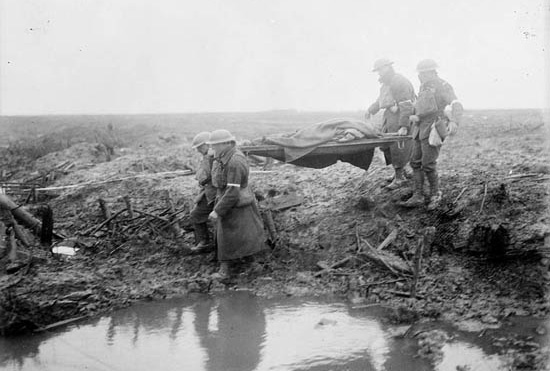Low flying German
First World War Audio Archive
Low flying German
Transcript
Photograph of Airman with spouse.
in the day time, they’d stop at some big place and we would all stay in barns or something through the day. The trains wouldn’t be moving. And then at night, they’d load up and keep moving on, moving on to get down to Amiens and so the Germans never knew the Canadians were down there. Right at the very last, when we got off the train while lining up to get into position and that there, we marched that night to get in position. We were the last battalion to move off in that scrap. We had the last objective to take. And when it come time to move up to go andAirman with his wife, holding his child.
take our objective, well, we were too far ahead and we didn’t have no support and Heinie was coming over. It was in the middle of the afternoon and he was flying right up and down low. By gosh, we were hiding under the galldarn... and drop down to the old Hindenburg Line all grown over, the trench was there and he was right down. We were shooting at him with the rifles there. You could see him sitting in the cockpit just as plain as anything, flying that low. Not a plane or no artillery supporting us at all because we’d advanced too far ahead. The Germans were just, artillery we were just, had the horses hooked ontoAirman with his arm around his wife.
a gun and were pulling out this little bush where we were, right along where our objective was. And we got this here horse. And one of the officers there, can’t think of his name, he rode that horse for quite a while. Kept it in the lines and back.Description
Mr. Skeates describes his company’s advance by train to Amiens, and a very close encounter with the German Air Force.
Charles Darwood Skeates
Charles Skeates was born in Ingersoll, Ontario on February 3, 1894. He worked as a barber until his enlistment at Swift Current, Saskatchewan on March 11, 1916 in the 209th Unit, 4th Infantry, despite his original hopes to be called into the cavalry. Arriving overseas in England in October, 1916, he joined the 9th Reserve Brigade at Bramshott and then the 128th at Whitley as a band member. He went into action as a member of the 46th Battalion, 10th Brigade. Mr. Skeates saw action in several major offensives; Passchendaele, Valenciens, Amiens, Drury Mill where he was wounded, and the Oppy Front. Mr. Skeates was a machine gunner during his tour of duty. After the war, he resumed his work as a barber and married Bessie Becker Maitland, on June 13, 1921. During the Second World War, he served as a barber with the RCAF in England, and finished his military service in 1968 after a 13 year stint in the Canadian Army. Mr. Skeates died on December 5, 1982.
Meta Data
- Medium:
- Video
- Owner:
- Veterans Affairs Canada
- Duration:
- 2:00
- Person Interviewed:
- Charles Darwood Skeates
- War, Conflict or Mission:
- First World War
- Location/Theatre:
- Europe
- Battle/Campaign:
- Amiens
- Branch:
- Army
- Units/Ship:
- 209th Unit
- Rank:
- Private
- Occupation:
- Gunner
Attestation
Related Videos
- Date modified:




